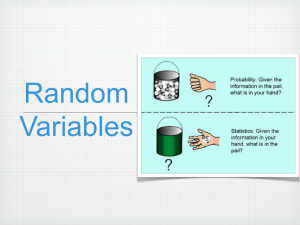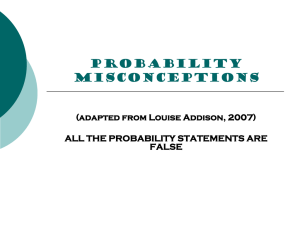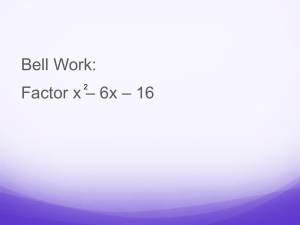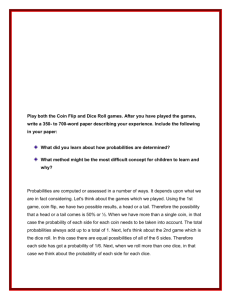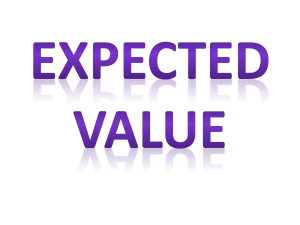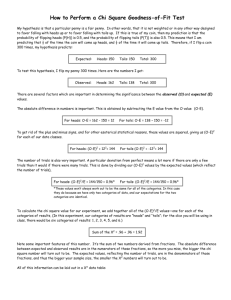Language of Probability
advertisement
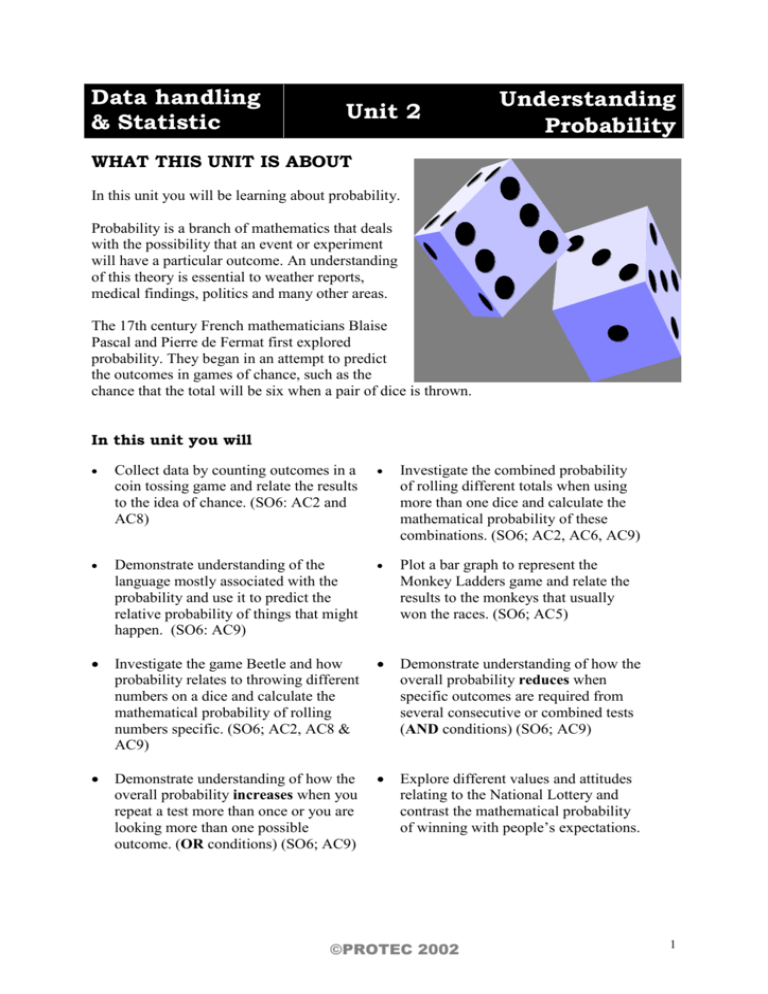
Data handling
& Statistic
Unit 2
Understanding
Probability
WHAT THIS UNIT IS ABOUT
In this unit you will be learning about probability.
Probability is a branch of mathematics that deals
with the possibility that an event or experiment
will have a particular outcome. An understanding
of this theory is essential to weather reports,
medical findings, politics and many other areas.
The 17th century French mathematicians Blaise
Pascal and Pierre de Fermat first explored
probability. They began in an attempt to predict
the outcomes in games of chance, such as the
chance that the total will be six when a pair of dice is thrown.
In this unit you will
Collect data by counting outcomes in a
coin tossing game and relate the results
to the idea of chance. (SO6: AC2 and
AC8)
Investigate the combined probability
of rolling different totals when using
more than one dice and calculate the
mathematical probability of these
combinations. (SO6; AC2, AC6, AC9)
Demonstrate understanding of the
language mostly associated with the
probability and use it to predict the
relative probability of things that might
happen. (SO6: AC9)
Plot a bar graph to represent the
Monkey Ladders game and relate the
results to the monkeys that usually
won the races. (SO6; AC5)
Investigate the game Beetle and how
probability relates to throwing different
numbers on a dice and calculate the
mathematical probability of rolling
numbers specific. (SO6; AC2, AC8 &
AC9)
Demonstrate understanding of how the
overall probability reduces when
specific outcomes are required from
several consecutive or combined tests
(AND conditions) (SO6; AC9)
Demonstrate understanding of how the
overall probability increases when you
repeat a test more than once or you are
looking more than one possible
outcome. (OR conditions) (SO6; AC9)
Explore different values and attitudes
relating to the National Lottery and
contrast the mathematical probability
of winning with people’s expectations.
©PROTEC 2002
1
Activity 1
Tossing a coin, an investigation
In this activity we are going to investigate the mathematics of tossing a
coin. You are going to look at the chances of getting a head (H) or a tail
(T) if a coin is tossed. You are then going to use
mathematics to represent the outcome so that you
can make predictions about what might happen
Chance is the
when you play this game.
probability of
different but
When you are using a coin to come to a
decision, both sides have an equal chance of
equally likely
winning. Tossing a tail or a head are equally
things
likely every time. That is why both sides are
happening.
willing to accept the decision.
1.1 Team Heads, Team tails, Who is the
winner?
These
happenings
are called
events.
To win this game you must toss more heads or tails than your partner
when you both toss a coin the same number of times.
Use the procedure below to play. Make sure you record the “events”, that is what
happened each time the coin was tossed.
How to play
1. Split your class into two teams called Team Heads and Team tails. If you give
everyone a number one or two around the class, then the one’s can be heads and the
two’s can be tails.
2. Each member of team heads should now pair up with one member of team tails. Each
pair will need a coin to toss.
3. Copy Table 1 on to your book so that everybody has a copy. You should make sure
that your records correspond with your partners at the end of the game.
4. Take turns to toss one coin, each person tosses ten times and do not forget to record
your outcomes.
5. If the coins fall off the table then toss again.
6. Use tallies (/) to represent your outcomes, (H / T) in the relevant block.
©PROTEC 2002
2
Table 1 – Individual Team Scores
Team heads
Toss
Number
1
2
3
4
5
6
7
8
9
10
Heads
Team Tails
Tails
Heads
Tails
Combined
Totals
Heads
Tails
Totals
1.2
You and your opponent
1 Who is the winner between you and your opponent? Team Heads or Team Tails?
2 Calculate the fractions below using each of your results:
H
,
Tosses
The number of heads tossed
T
,
Tosses
The number of tails tossed
H
T
Tosses Tosses
Total H
Total Tosses
Total T
Total Tosses
Total H
Total T
Total Tosses Total Tosses
10 (the total number of tosses
10 (the total number of tosses
Probability and Fractions
Probability is expressed as fractions, ratios or
percentages of:
The number of times something happened The
total number of times you tried
3 What can you say about the winners “probability” fractions when compared to the
loser?
©PROTEC 2002
3
1.3 Overall Winner?
Draw up a table like table 2. Collect the data from each
pair and enter it into the table. Then answer the questions
below.
1.
How many times did 5the Team Tails player
win?
2.
How many times did the Team Heads player
win?
3.
Did team Heads or Team Tails win overall?
How do you know?
4.
How many pairs tossed the same number of
Heads and Tails?
5.
Calculate the Heads Probability Ratios for each
pair in your class.
Table 2 – Combined Class
Tosses
Combined
Pairs
Totals or
Number
Outcomes
Heads
Tails
1
2
3
4
etc
Total
6.
Why do you think you do not need to calculate both ratios?
7.
Calculate the Total Heads Probability Ratio (Heads
you who won or lost? Explain.
8.
What can you say about the probability of throwing heads compared to the
probability of throwing tails?
9.
If you had done 1000 tosses each, approximately how many times would you have
tossed heads? How do you know this?
Total tosses)? Does this tell
10. What do you think is the probability of tossing Heads if you toss a coin once?
11. What do you think is the probability of getting a Tail if you toss the coin once?
12. Write your answers in a mathematical form using the notation like the example
below:
P(heads)
Likely number of Heads
Total Number of throws
13. What do you think is the probability of getting either a Head or a Tail if you toss a
coin once?
14. If the probability of something happening is 1, what can you say about that
happening?
15. Explain what you understand by “chance” ? Why is it that you will never be able to
predict exactly how many Heads or Tails you will toss in an experiment like the one
above?
16. What do think the mathematical idea of probability can help you to predict?
©PROTEC 2002
4
Activity 2
Language of Probability
In this activity you will learn about common terms in the study of probability and you will
arrange these terms according to what they mean or the weight they carry in the probability
washing line. The extreme ends in probability are such that something is going to happen for
sure or it is not going to happen at all, but it is always
Work in-groups of five or six for
all the activities below.
2.3 Words to describe
probability
Look at the words in the box
shown. They are all different ways
of describing the probability of
something happening.
Organise them into a table like the
one below so that each column
describes the same approximate
probability of something happening.
Maybe
Likely
No
Chance
More
Likely
Good
Chance
Probable
Possible
Certain
Very
Unlikely
Outside
chance
Even
Chance
Poor
Chance
Less
Likely
Very
Likely
Equally
Likely
Impossible
No way
Might
Happen
Unlikely
Most likely
50-50
Least Likely
2.3 Making a probability Washing Line
Use the procedure below to make a probability washing line:
1. Choose 5 descriptions that can represent different
probabilities of something happening on a scale from most
likely to least likely. Write these descriptions onto 5
different pieces of paper. These will be your Probability
tags.
You will Need
String,
sticky tape,
measuring
tape
probability
tags,
2. Measure and cut your string one metre long.
3. Hang the string between two tables or along the wall. You an use sticky tape or prestik
to secure the ends.
©PROTEC 2002
5
4. Hang your “most likely” probability tag on one end and your “least likely” tag on the
other.
5. Arrange all the other tags in between the two extremes to make a continuous
probability scale.
2.3 Events and Probability
Read each of the possibilities below. Discuss where you would place each one on your
probability washing line? When you agree, tie a piece of string onto the washing line at
the appropriate position.
1. Winning 5 Million rand on the lottery?
2. Toss a coin and get a tail?
3. A triangle will have three sides.
4. A shark will suddenly appear in your left nostril.
5. Government will win the battle against crime in the next
fifteen years.
6. You will throw a dice and get a
ten
7. Everybody will have a house
the following year if we vote
for the DA in the next
elections.
Probability is about
predicting what might
happen rather than knowing
what is going to happen
2.4 Expressing Probabilities as
numbers
Putting Numbers on Probabilities
Now look again at the possibilities
listed above. Give each one a number
between 0 and 1 where 0 means that it
is absolutely impossible and 1 means
that the event is definite or a certainty.
If something is not impossible but it is
very unlikely for example, give it a
probability score very close to (but
not equal to) zero, e.g.
P(winning lottery) = 0,00000001
or 1 in a trillion.
A probability of zero (0) represents an event
that will never happen or an impossible
event. Throwing a 7 when using one dice
would be impossible and the event has a
probability of zero, 0.
A probability of one (1) represents an event
that must happen or a certainty. Scoring at
least 2 when you throw two dice at the same
time is a certainty and the event has a
probability of 1.
Probability values between 0 and 1
represent possibilities. The closer the
probability value is to 1, the more likely an
event is to happen. The closer the value is to
0, the less likely an event is to happen.
©PROTEC 2002
6
Activity 3
The Beetle Game and Calculating Probability
In this activity you are going to play a game called beetle using a dice.
The idea is to draw different parts of a beetle by throwing
different numbers on a dice. You will then look at how to
calculate the probability or chance of throwing the numbers you
need and relate the probability values to the parts of the
beetle you found difficult to throw.
3.1 Beetle, a probability game
Play this game in groups of 5 or six people. The wining group is the
one who draws the beetle the fastest using the fewest number of
throws of the dice.
How to play Beetle
You will need
paper
pencils
a dice
Each group member throws the dice and hands on to
the next ember.
2
If you can, the group draws the part of the beetle
represented by the number on the dice.(see diagram
opposite)
3
One group member should record each throw in a
table like the one shown below.
4
The group continues to pass the dice on and throw
until you have draw the full Beetle.
5
When you have a full beetle you should shout Beetle to stop the game.
Throw
1
The Rules
You cannot draw legs or
spots before you draw the
body.
You cannot draw eyes or
tentacles before you draw
the head.
Player
1
2
3
4
5
6
1
2
3
4
5
6
7
8
9
10
11
12
©PROTEC 2002
7
3.2 Probability and the Beetle game
How many times do you
need to roll a dice / die
to complete the beetle?
How many different
parts did you have to
draw?
What was the minimum
number of throws
possible to complete the
beetle?
The Mathematical Definition of Probability
The probability of an event A occurring is defined as:
P(event A) = __Number of ways that event A can occur___
The total number of possible outcomes.
Calculate the probability
of throwing a 1 for the
head on the first throw.
What was the hardest
part of the beetle to
complete? Why do you
think this is?
What was the total
number of throws the
winner threw?
An outcome is the result of a single trial of an
experiment. In the case of rolling one die all of the
outcomes can be represented as a set, S ={1,2,3,4,5,6.
Each of these can only occur once per throw, therefore
the number of ways to throw a particular number will be
one per throw.
The total number of possible outcomes is 6, because
there are 6 numbers.
P(Throwing a four)) =
All the faces have an equal chance of coming up.
1
in the case of a dice.
6
Therefore all the numbers have an equal probability (
1
)
6
for one throw of a dice.
Count how many times
each umber was thrown during the game. What can you say about the probability of
throwing each number?
Calculate the probability of throwing either a head (1) or a body (3) with the first throw of
the dice:
P(head or a body)
=
Number of ways (choices)
Total number of possibilities
In theory, how many groups should have been able to draw a head or a body on the first
throw?
How many groups did throw a head or a body on the first throw?
OR Conditions,
Increasing your chances
If you want to throw a specific number you can increase your chances by
throwing more than once. Each time you throw you add the probability of
a single throw.
P(4 from two throws) =P(4 from one throw) + P(4 from one throw).
P(3 from 4 throws) = 4 P(3 from one throw)
If you want to throw more than one specific number (e.g. 1 OR 3) the
same applies. You add the probability of throwing each individual number
©PROTEC 2002
8
Activity 4
Monkey Ladders, Probability and two dice
In this activity you are going to look at the combined totals when you throw two dice, i.e.
{2,3,4,5,6,7,8,9,10,11,12}. You are going to use these numbers to race Monkeys up different
ladders. Eleven monkeys will participate. Each monkey will move one step up their ladder,
every time their combined total is thrown using two dice.
4.1 Monkey Ladders
In this race a monkey climbs every time its favourite total number
is rolled. Take turns in your group to roll both dice at the same
time. Use a coin or a stone to mark the position of each monkey.
Each member of your group should choose which monkey they
think will win and which monkey will come last. Record your
choices. Then play.
4.2
The Winning
Monkey
The winning
monkey is the first
monkey to climb 7
rungs of the ladder.
Monkey Ladders and Probability
1
Which monkey won in your group? Why do you think this monkey won?
2
Which monkey came last? Why do think they came last?
3
Is the race fair? Why do you say this?
4 Choose three monkeys that are likely to win most of the time. Explain your choice
5 Choose four monkeys that are likely to come last most of the time. Explain your
choice.
6
How many different ways are there to roll a double 1?
7
How many different ways are there to roll a total of 7?
©PROTEC 2002
9
4.3 Probability bar graph.
You are now going to calculate the theoretical probabilities of rolling all the totals for all of
the monkeys. To do this you need two pieces of information for each possibility:
The number of different ways to roll the monkeys favourite number
The total number of different throws possible.
Each probability ca then be calculated using the probability formula below:
P(total number) = Number of different ways to get that number
Total number of different combinations possible
A
B
Complete the table below by
working out how many ways
there are of throwing each of the
monkeys favourite numbers.
Then calculate the total number
of different combinations.
Use the formula
above to calculate
probabilities of
rolling the totals in
brackets using two
dice:
C
Use these
probabilities to
deduce those for:
D
P(2)
P(4)
P(6)
P(9)
P(10)
P(11)
Monkeys
favourite
number
2
3
4
5
6
P(6) = ?
Different rolls to give a total of six;
(1,5), (2,4), (3,3), (4,2), (5,1)
There are 5 different ways to roll a 6.
There are 11 different totals that can be
rolled
Dice
combinations
Number of
possibilities
(1,5), (2,4), (3,3),
(4,2), (5,1)
5
7
8
9
10
11
12
Total number of different
combinations possible.
P(3)
P(5)
P(7)
P(8)
P(12)
Plot the number of
possibilities for each
total on a “monkey ladder bar graph” like the one shown. How does this graph relate
to the finishing positions of your groups monkey race?
©PROTEC 2002
10
Activity 5
Lottery Alert
Is the Lottery a good thing? Is it going to make everybody rich? Does it make any people
poorer?
In this activity you are going look at how easy or difficult it is to win the Lottery. What are
the chances? Somebody said that the chance of winning the jackpot in the National Lottery is
1 in 14 million chances. This means if you try 14 million times you might win only once. In
money terms this means that you will pay 14 million x R2.50 = 35 million in tickets to win
once.
5.1 Analysing the Lotto
In the South African National Lottery, six balls are selected at random from forty-nine
numbered balls. Players have to guess which balls will be drawn. If they get all six correct,
they win the jackpot prize. Answer the questions below about this situation.
1. You have chosen 6 numbers, what is
the probability of the first ball
matching one of your six numbers?
Rolling Probabilities, The P(of
one event) AND P(another event)
2. Assuming you have matched the
first ball, you now have 5 numbers
left to match and there are only 48
balls left. What is the probability of
matching the second ball.
When you have two possibilities and you
want to calculate the overall probability of
BOTH happening, You multiply the two
probabilities together.
3. Assume you go on winning,
calculate the following probabilities
(in order):
For example, the probability of rolling a six
on a dice and then rolling another six is:
P(6) AND P(6) =
1 1
1
6 6 36
P(matching ball 3).
P(matching ball 4)
P(matching ball 5)
You can check this by looking at your
Monkey Ladders table for throwing 12
(double 6)
P(matching ball 6)
4. Now calculate the rolling probability of matching all of the 6 balls, i.e. :
P(ball 1) AND P(ball 2) AND P(ball 3) AND P(ball 4) AND P(ball 5) AND P(ball 6)
5 Was the person who said that the chances of winning were 1 in 14 million correct?
Explain how the probability you calculated above relates to your chances of wining.
©PROTEC 2002
11
5.2 What you think about the Lotto
Are the statements below true or false? Why do you say this? Discuss these issues in your
group and prepare a summary of your opinions to present to the class.
If you play the lotto for long enough you are sure to win?
You will only win if you follow your Gut feeling.
Luck doesn’t exist.
Poor people are eating less bread because of the Lotto
You need skill to play the Lotto.
Only the organisers of the Lotto make money. They are making millions in profits
so most people must be losing.
The Lotto makes us believe we can win but probability calculations prove that
winning is almost impossible.
P(event A)
Number of ways that event A can occur
The total number of possible outcomes
Probability Summary
1. Mathematical probability is a way of describing the chance of one thing
happening when there are several equally likely things that might
happen.
2. Mathematical probability values are always between 0 and 1 and are
defined as:
P(event A)
3
Number of ways that event A can occur
The total number of possible outcomes
OR Conditions occur when you repeat a test more than once or you
are looking more than one possible outcome. In the case of OR
conditions, the overall probability increases and you add the
individual probabilities of each test to get the overall probability of the
combination.
P(event A OR event B) P(event A) P(event B)
4
AND conditions occur when specific outcomes are required from
several consecutive or combined tests. In the case of AND conditions,
the overall probability decreases and you multiply the individual
probabilities of each test to get the overall probability of the
combination.
P(event A AND event B) P(event A) P(event B)
©PROTEC 2002
12

